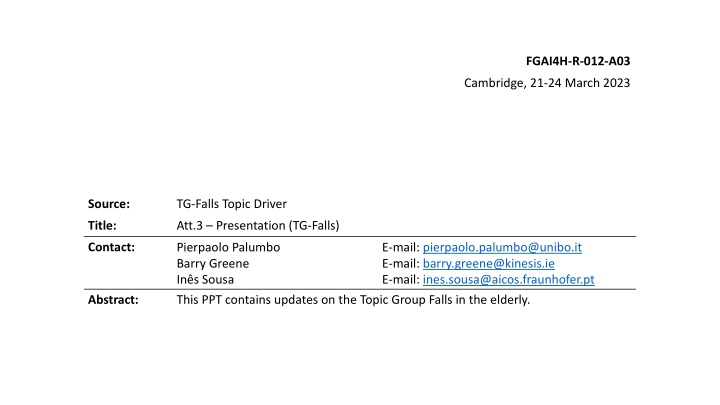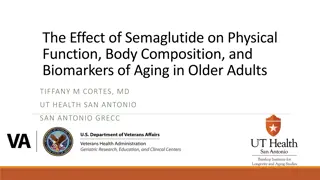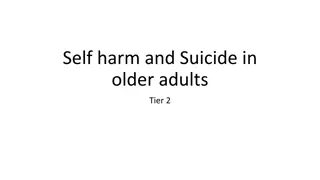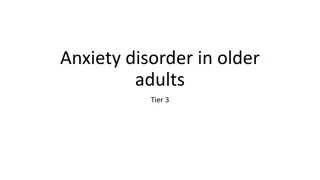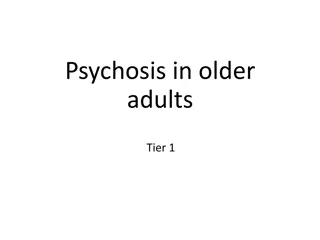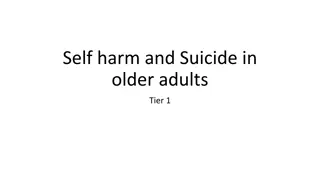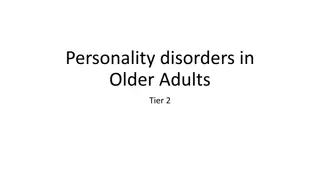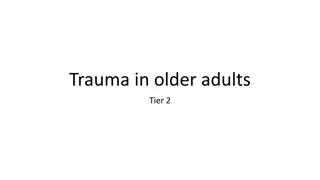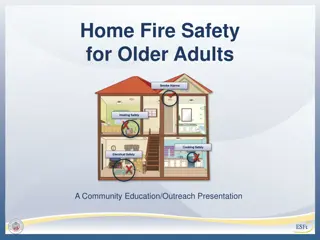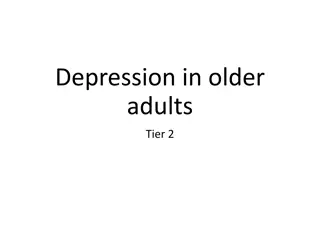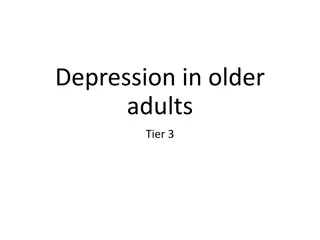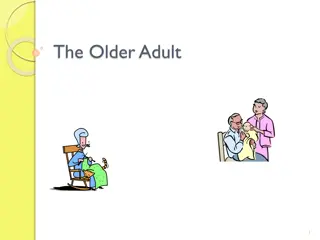Advances in Fall Risk Assessment and Management for Older Adults
This presentation delves into updates on the stratification tool for fall risk in community-dwelling older adults, emphasizing the importance of early intervention through opportunistic health visits. It discusses a decision tree model for assessing fall risk, highlighting the significance of history of falls, fall severity, and gait impairment in determining risk levels. Additionally, the presentation advocates for multifactorial models in fall risk assessment and underlines the need for validation and usability in such models. The future direction includes exploring AI and clinical decision support systems for enhanced risk estimation and intervention recommendations.
Download Presentation

Please find below an Image/Link to download the presentation.
The content on the website is provided AS IS for your information and personal use only. It may not be sold, licensed, or shared on other websites without obtaining consent from the author.If you encounter any issues during the download, it is possible that the publisher has removed the file from their server.
You are allowed to download the files provided on this website for personal or commercial use, subject to the condition that they are used lawfully. All files are the property of their respective owners.
The content on the website is provided AS IS for your information and personal use only. It may not be sold, licensed, or shared on other websites without obtaining consent from the author.
E N D
Presentation Transcript
FGAI4H-R-012-A03 Cambridge, 21-24 March 2023 Source: TG-Falls Topic Driver Title: Att.3 Presentation (TG-Falls) Contact: Pierpaolo Palumbo Barry Greene In s Sousa This PPT contains updates on the Topic Group Falls in the elderly. E-mail: pierpaolo.palumbo@unibo.it E-mail: barry.greene@kinesis.ie E-mail: ines.sousa@aicos.fraunhofer.pt Abstract:
Outline Commentary on the stratification tool for community-dwelling older adults of the World Guidelines for Falls Prevention and Management for Older Adults Systematic review and individual participant data meta-analysis
Commentary Decision tree for fall risk stratification, assessment, and intervention Two entry points: i) opportunistic/annal health visit, ii) presenting to healthcare after a fall Three binary split nodes: i) history of falls or 3KQ, ii) fall severity, iii) gait and balance impairment Three output risk strata. i) low, ii) intermediate, iii) high risk
Commentary Submitted, Under review
Commentary Model design Advocacy for multifactorial models Validation Need for validation Usability Need to address the usability-performance trade-off Potential effects Need to estimate the proportion at risk and the effects of opportunistic health visits Advantages of a continuous risk score Future research Risk estimation + intervention recommendations, AI, clinical decision support systems
Systematic review and individual participant data meta-analysis Review title: Systematic review and individual participant data meta-analysis of publicly available datasets for wearable inertial sensor-based fall risk assessment Review on datasets for wearable inertial sensor- based fall prediction Aim/question: Which datasets are available for training and validating models for wearable inertial sensor-based fall risk assessment? * What is the prognostic value for falls of features derived from wearable inertial sensors? Analyses on the pooled dataset * Khan, S. M. et al. A global review of publicly available datasets for ophthalmological imaging: barriers to access, usability, and generalisability. Lancet Digit. Heal.3, e51 e66 (2021).
Systematic review and individual participant data meta-analysis Inclusion criteria: Peer-reviewed articles/conference proceedings in English including datasets with the following characteristics: Datasets including at least 20 individuals Datasets where the predicting features comprised of at least one inertial sensor-based feature Datasets from any community-dwelling population Datasets with individual-level (not aggregated) information about falls* Falls collected after the predicting features (prospective design) # Review on datasets for wearable inertial sensor- based fall prediction * occurrence of at least one fall in a given time period OR number of falls OR date of first fall occurrence # retrospective studies included only for sensitivity analyses Analyses on the pooled dataset Registration: PROSPERO 2022 CRD42022367394 https://www.crd.york.ac.uk/prospero/display_record.php?RecordID=367394
Systematic review and individual participant data meta-analysis Review team: Jose Luis Albites Sanabria, University of Bologna, Bologna, Italy Barry Greene, Kinesis Health Technologies Ltd, Dublin, Ireland Killian McManus, Kinesis Health Technologies Ltd, Dublin, Ireland Luca Palmerini, University of Bologna, Bologna, Italy Pierpaolo Palumbo, University of Bologna, Bologna, Italy In s Sousa, Fraunhofer Portugal AICOS, Porto, Portugal Kimberley S. van Schooten, University of New South Wales, Sydney, Australia Review of datasets for wearable inertial sensor- based fall prediction Analyses on the pooled dataset Two sub-teams for screening and feature extraction. Each sub-team: 2 independent reviewers 1 reviewer for solving disagreement
Systematic review and individual participant data meta-analysis Quality assessment: PROBAST (Prediction model Risk Of Bias ASsessment Tool) [2] Risk of bias, applicability Participants, predictors, outcome, analysis 11 + 9 signalling questions Features to extract [1]: Study population Sampled population Sample size Geographic location Study design Clinical features for fall prediction Characteristics of inertial sensors (acc., acc. + gyro, etc.) Protocol for inertial sensor assessment (sensor location, standardized task/free living) Outcome measures Fall definition Protocol for collecting fall information (fall diaries, phone calls, etc.) Dataset accessibility (open access, open access with barriers, regulated access, not accessible) [1] Moons KGM et al. Critical appraisal and data extraction for systematic reviews of prediction modelling studies: the CHARMS checklist. PLoS Med. 2014 Oct ;11(10):e1001744. [2] Wolff RF et al. PROBAST: A tool to assess the risk of bias and applicability of prediction model studies. Ann Intern Med. 2019 Jan 1;170(1):51 8.
Systematic review and individual participant data meta-analysis Access request: Email Form: rationale, data management, authorship policy [1] Review on datasets for wearable inertial sensor- based fall prediction Meta-analysis: Data storage facility: secure, large Two possibilities Share data: one-stage IPD meta-analysis Share only algorithms and results: two-stage IPD meta-analysis Univariate analysis: i) ORs, RaRs, and HRs, ii) Mixed-effect logistic regressions Multivariate model [2] Analyses on the pooled dataset [1] https://www.icmje.org/recommendations/browse/roles-and-responsibilities/defining-the-role-of-authors-and-contributors.html [2] Ahmed I, Debray TPA, Moons KGM, Riley RD. Developing and validating risk prediction models in an individual participant data meta-analysis. BMC Med Res Methodol. 2014;14(3).
Systematic review and individual participant data meta-analysis Google Dataset Search Mendeley Data, IEEE DataPort, Physionet, Figshare, Dataverse, Dryad, hand search PubMed: 26 reviews, Web of Science: 23 reviews, Scopus: 33 reviews To do 19 unique review articles 834 articles to screen 19 duplicates removed 815 articles screened for title and abstract 690 articles excluded To do 125 articles to screen for full-text eligibility No IMU: n = 3 Wrong outcomes: n = 4 No info on falls: n = 25 Less than 20 subjects: n = 4 Non community-dwelling: n = 6 Retrospective: n = 51 Feature extraction Access request One/two-stage IPD meta-analysis 93 articles excluded 32 articles included in the review
